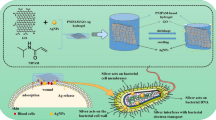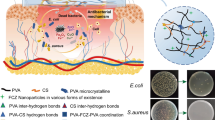Abstract
Wound healing is a complicated and dynamic process, and its acceleration and improvement require the preparation of a desirable environment. Wound dressing is one of the most effective external agents in the process of wound healing. The objective of the present study is to investigate the physical, mechanical, and biological characteristics of nano-Reduced Graphene Oxide (nano-rGO)-reinforced polyvinyl alcohol/polyvinylpyrrolidone polymer network wound dressings. Using the Fourier-Transform Infrared (FTIR) spectroscopy, we have confirmed the existence of fumaric acid (FA) as the cross-linking agent by creating ester groups. Moreover, X-Ray Diffraction (XRD) analysis showed that adding nano-rGO and FA to the hydrogel structure created peaks at 2θ = 10º and 29.5º, respectively. Field emission scanning electron microscopy (FESEM) analysis showed the formation of a coating with a uniform structure and regular pores. In addition, elemental EDX analysis confirmed the uniform distribution of hydrogel film constituents in the wound dressing structure. The swelling test showed that increasing the amount of nano-rGO in wound dressings decreased the water absorption by 16.33 percent and decreased the Water Vapor transmittance Rate (WVTR) to 26.5 percent. The gel fraction test showed that all hydrogel films have a gel fraction of more than 95 percent. Cytotoxicity and inhibition zone tests on the produced wound dressings showed that by controlling the amount of nano-rGO, we could produce wound dressings with no toxicity on cells that demonstrate desirable antibacterial characteristics.












Similar content being viewed by others
References
Radmanesh S, Shabangiz S, Koupaei N, Hassanzadeh-Tabrizi S (2022) 3D printed bio polymeric materials as a new perspective for wound dressing and skin tissue engineering applications: a review. J Polym Res 29(2):1–25
Salehi-Abari M, Koupaei N, Hassanzadeh-Tabrizi S (2020) Synthesis and Characterisation of semi-interpenetrating network of Polycaprolactone/polyethylene glycol diacrylate/zeolite-CuO as wound dressing. Mater Technol 35(5):290–299
Bozoğlan BK, Duman O, Tunç S (2020) Preparation and characterization of thermosensitive chitosan/carboxymethylcellulose/scleroglucan nanocomposite hydrogels. Int J Biol Macromol 162:781–797
Polat TG, Duman O, Tunc S (2020) Agar/κ-carrageenan/montmorillonite nanocomposite hydrogels for wound dressing applications. Int J Biol Macromol 164:4591–4602
Bozoğlan BK, Duman O, Tunç S (2021) Smart antifungal thermosensitive chitosan/carboxymethylcellulose/scleroglucan/montmorillonite nanocomposite hydrogels for onychomycosis treatment. Colloids Surf Physicochem Eng Aspects 610:125600
Huang M, Hou Y, Li Y, Wang D, Zhang L (2017) High performances of dual network PVA hydrogel modified by PVP using borax as the structure-forming accelerator. Des Monomers Polym 20(1):505–513
Zhao L, Mitomo H, Zhai M, Yoshii F, Nagasawa N, Kume T (2003) Synthesis of antibacterial PVA/CM-chitosan blend hydrogels with electron beam irradiation. Carbohydr Polym 53(4):439–446
Kamoun EA, Chen X, Mohy Eldin MS, Kenawy E-RS (2015) Crosslinked poly(vinyl alcohol) hydrogels for wound dressing applications: A review of remarkably blended polymers. Arab J Chem 8(1):1–14
Hyon S-H, Cha W-I, Ikada Y, Kita M, Ogura Y, Honda Y (1994) Poly (vinyl alcohol) hydrogels as soft contact lens material. J Biomater Sci Polym Ed 5(5):397–406
Yang X, Liu Q, Chen X, Yu F, Zhu Z (2008) Investigation of PVA/ws-chitosan hydrogels prepared by combined γ-irradiation and freeze-thawing. Carbohydr Polym 73(3):401–408
Muggli DS, Burkoth AK, Anseth KS (1999) Crosslinked polyanhydrides for use in orthopedic applications: degradation behavior and mechanics. J Biomed Mater Res Official J Soc Biomateri Jpn Soc Biomater Aust Soc Biomater 46(2):271–278
Coviello T, Matricardi P, Marianecci C, Alhaique F (2007) Polysaccharide hydrogels for modified release formulations. J Controlled Release 119(1):5–24
Yao L, Haas TW, Guiseppi-Elie A, Bowlin GL, Simpson DG, Wnek GE (2003) Electrospinning and stabilization of fully hydrolyzed poly (vinyl alcohol) fibers. Chem Mater 15(9):1860–1864
Li Y, Yao S (2017) High stability under extreme condition of the poly (vinyl alcohol) nanofibers crosslinked by glutaraldehyde in organic medium. Polym Degradation Stab 137:229–237
Li J, Li Y, Niu S, Liu J, Wang L (2017) Synthesis of a new “green” sponge via transesterification of dimethyl carbonate with polyvinyl alcohol and foaming approach. J Porous Mater 24(6):1595–1604
Wu K, Song L, Wang Z, Hu Y (2008) Microencapsulation of ammonium polyphosphate with PVA–melamine–formaldehyde resin and its flame retardance in polypropylene. Polym Adv Technol 19(12):1914–1921
Destaye AG, Lin C-K, Lee C-K (2013) Glutaraldehyde vapor cross-linked nanofibrous PVA mat with in situ formed silver nanoparticles. ACS Appl Mater Interfaces 5(11):4745–4752
Sonker AK, Tiwari N, Nagarale RK, Verma V (2016) Synergistic effect of cellulose nanowhiskers reinforcement and dicarboxylic acids crosslinking towards polyvinyl alcohol properties. J Polym Sci Part A Polym Chem 54(16):2515–2525
Kurkuri MD, Aminabhavi TM (2004) Poly (vinyl alcohol) and poly (acrylic acid) sequential interpenetrating network pH-sensitive microspheres for the delivery of diclofenac sodium to the intestine. J Controlled Release 96(1):9–20
Tang Y-F, Du Y-M, Hu X-W, Shi X-W, Kennedy JF (2007) Rheological characterisation of a novel thermosensitive chitosan/poly (vinyl alcohol) blend hydrogel. Carbohydr Polym 67(4):491–499
Gohil J, Bhattacharya A, Ray P (2006) Studies on the crosslinking of poly (vinyl alcohol). J Polym Res 13(2):161–169
Kariduraganavar MY, Kulkarni SS, Kittur AA (2005) Pervaporation separation of water–acetic acid mixtures through poly (vinyl alcohol)-silicone based hybrid membranes. J Membr Sci 246(1):83–93
Prajapati G, Roshan R, Gupta P (2010) Effect of plasticizer on ionic transport and dielectric properties of PVA–H3PO4 proton conducting polymeric electrolytes. J Phys Chem Solids 71(12):1717–1723
Yin Y, Li J, Liu Y, Li Z (2005) Starch crosslinked with poly (vinyl alcohol) by boric acid. J Appl Polym Sci 96(4):1394–1397
Gouda M, Badr S, Hassan M, Sheha E (2011) Impact of ethylene carbonate on electrical properties of PVA/(NH4)2SO4/H2SO4 proton-conductive membrane. Ionics 17(3):255–261
Duman O, Uğurlu H, Diker CÖ, Tunç S (2022) Fabrication of highly hydrophobic or superhydrophobic electrospun PVA and agar/PVA membrane materials for efficient and selective oil/water separation. J Environ Chem Eng 10(3):107405
Duman O, Polat TG, Tunç S (2022) Development of poly (vinyl alcohol)/β-cyclodextrin/P (MVE-MA) composite nanofibers as effective and selective adsorbent and filtration material for the removal and separation of cationic dyes from water. J Environ Manag 322:116130
Duman O, Diker CÖ, Uğurlu H, Tunç S (2022) Highly hydrophobic and superoleophilic agar/PVA aerogels for selective removal of oily substances from water. Carbohydr Polym 286:119275
Razzak M, Dewi S, Lely H, Taty E (1999) The characterization of dressing component materials and radiation formation of PVA–PVP hydrogel. Radiat Phys Chem 55(2):153–165
Kamoun EA, Kenawy E-RS, Chen X (2017) A review on polymeric hydrogel membranes for wound dressing applications: PVA-based hydrogel dressings. J Adv Res 8(3):217–233
Himly N, Darwis D, Hardiningsih L (1993) Poly (n-vinylpyrrolidone) hydrogels: 2. Hydrogel composites as wound dressing for tropical environment. Radiat Phys Chem 42(4–6):911–914
Boateng JS, Matthews KH, Stevens HN, Eccleston GM (2008) Wound healing dressings and drug delivery systems: a review. J Pharm Sci 97(8):2892–2923
Hassanzadeh-Tabrizi S, Norbakhsh H, Pournajaf R, Tayebi M (2021) Synthesis of mesoporous cobalt ferrite/hydroxyapatite core-shell nanocomposite for magnetic hyperthermia and drug release applications. Ceram Int 47(13):18167–18176
Talaei M, Hassanzadeh-Tabrizi S, Saffar-Teluri A (2021) Synthesis of mesoporous CuFe2O4@ SiO2 core-shell nanocomposite for simultaneous drug release and hyperthermia applications. Ceram Int 47(21):30287–30297
Bigham A, Hassanzadeh-Tabrizi S, Rafienia M, Salehi H (2016) Ordered mesoporous magnesium silicate with uniform nanochannels as a drug delivery system: The effect of calcination temperature on drug delivery rate. Ceram Int 42(15):17185–17191
Bigham A, Aghajanian AH, Allahdaneh S, Hassanzadeh-Tabrizi S (2019) Multifunctional mesoporous magnetic Mg2SiO4–CuFe2O4 core-shell nanocomposite for simultaneous bone cancer therapy and regeneration. Ceram Int 45(15):19481–19488
Bigham A, Aghajanian AH, Behzadzadeh S, Sokhani Z, Shojaei S, Kaviani Y, Hassanzadeh-Tabrizi S (2019) Nanostructured magnetic Mg2SiO4-CoFe2O4 composite scaffold with multiple capabilities for bone tissue regeneration. Mater Sci Eng C 99:83–95
Khamsehashari N, Hassanzadeh-Tabrizi S, Bigham A (2018) Effects of strontium adding on the drug delivery behavior of silica nanoparticles synthesized by P123-assisted sol-gel method. Mater Chem Phys 205:283–291
Ansari M, Bigham A, Hassanzadeh-Tabrizi S, Ahangar HA (2017) Synthesis and characterization of Cu0.3Zn0.5Mg0.2Fe2O4 nanoparticles as a magnetic drug delivery system. J Magn Magn Mater 439:67–75
Ali NH, Amin MCIM, Ng S-F (2019) Sodium carboxymethyl cellulose hydrogels containing reduced graphene oxide (rGO) as a functional antibiofilm wound dressing. J Biomater Sci Polym Ed 30(8):629–645
Khan MUA, Haider S, Raza MA, Shah SA, Abd Razak SI, Kadir MRA, Subhan F, Haider A (2021) Smart and pH-sensitive rGO/Arabinoxylan/chitosan composite for wound dressing: In-vitro drug delivery, antibacterial activity, and biological activities. Int J Biol Macromol 192:820–831
Compton OC, Nguyen ST (2010) Graphene oxide, highly reduced graphene oxide, and graphene: versatile building blocks for carbon-based materials. Small 6(6):711–723
Fan Z, Liu B, Wang J, Zhang S, Lin Q, Gong P, Ma L, Yang S (2014) A novel wound dressing based on Ag/graphene polymer hydrogel: effectively kill bacteria and accelerate wound healing. Adv Funct Mater 24(25):3933–3943
Usman A, Hussain Z, Riaz A, Khan AN (2016) Enhanced mechanical, thermal and antimicrobial properties of poly (vinyl alcohol)/graphene oxide/starch/silver nanocomposites films. Carbohydr Polym 153:592–599
Hemmatgir F, Koupaei N, Poorazizi E (2022) Characterization of a novel semi-interpenetrating hydrogel network fabricated by polyethylene glycol diacrylate/polyvinyl alcohol/tragacanth gum as a wound dressing. Burns 48(1):146–155
Gonzalez JS, Ludueña LN, Ponce A, Alvarez VA (2014) Poly (vinyl alcohol)/cellulose nanowhiskers nanocomposite hydrogels for potential wound dressings. Mater Sci Eng, C 34:54–61
Shojaei S, Hassanzadeh-Tabrizi S, Ghashang M (2014) Reverse microemulsion synthesis and characterization of CaSnO3 nanoparticles. Ceram Int 40(7):9609–9613
Pournajaf R, Hassanzadeh-Tabrizi S, Jafari M (2014) Reverse microemulsion synthesis of CeO2 nanopowder using polyoxyethylene (23) lauryl ether as a surfactant. Ceram Int 40(6):8687–8692
Basha S, Kumar KV, Sundari GS, Rao M (2018) Structural and electrical properties of graphene oxide-doped PVA/PVP blend nanocomposite polymer films. Adv Mater Sci Eng
Hassanzadeh-Tabrizi S, Nguyen C-C, Do T-O (2019) Synthesis of Fe2O3/Pt/Au nanocomposite immobilized on g-C3N4 for localized plasmon photocatalytic hydrogen evolution. Appl Surf Sci 489:741–754
Yook S-H, Kim S-H, Park C-H, Kim D-W (2016) Graphite–silicon alloy composite anodes employing cross-linked poly (vinyl alcohol) binders for high-energy density lithium-ion batteries. RSC Adv 6(86):83126–83134
Dilaver M, Yurdakoc K (2016) Fumaric acid cross-linked carboxymethylcellulose/poly (vinyl alcohol) hydrogels. Polym Bull 73(10):2661–2675
Ma J, Li Y, Yin X, Xu Y, Yue J, Bao J, Zhou T (2016) Poly (vinyl alcohol)/graphene oxide nanocomposites prepared by in situ polymerization with enhanced mechanical properties and water vapor barrier properties. RSC Adv 6(55):49448–49458
Duman O, Diker CÖ, Tunç S (2021) Development of highly hydrophobic and superoleophilic fluoro organothiol-coated carbonized melamine sponge/rGO composite absorbent material for the efficient and selective absorption of oily substances from aqueous environments. J Environ Chem Eng 9(2):105093
Ma J, Liu C, Li R, Wang J (2012) Properties and structural characterization of chitosan/poly (vinyl alcohol)/graphene oxide nano composites. e-Polymers 12(1)
Heo Y, Im H, Kim J (2013) The effect of sulfonated graphene oxide on sulfonated poly (ether ether ketone) membrane for direct methanol fuel cells. J Membr Sci 425:11–22
Eshagh S, Abbaspour-Fard MH, Hosseini F, Tabasizadeh M (2019) Effect of zinc oxide nanoparticles on mechanical, thermal and biodegradability of gelatin-based biocomposite properties films. Iran J Polym Sci Technol 32(5):411–426
Nikfar N, Izadi-Vasafi H, Goudarzi L (2019) Assessment of the microstructure and mechanical properties of polycarbonate (PC)/acrylonitrile butadiene rubber (NBR) blends reinforced with multi-wall carbon nanotubes. J Macromol Sci Part B 58(9):760–771
Author information
Authors and Affiliations
Corresponding author
Ethics declarations
Conflict of interest
The authors declare no conflict of interest.
Additional information
Publisher's Note
Springer Nature remains neutral with regard to jurisdictional claims in published maps and institutional affiliations.
Highlights
• Novel semi-interpenetrating hydrogel networks of PVA/PVP/ nano-rGO were synthesized as a wound dressing.
• The PVA/PVP/nano-rGO components showed excellent dispersion and strong interactions.
• Hydrogel dressings are crosslinked as hydrophilic polymers.
• PVA/PVP/rGO network can be a great hydrogel for wound dressing.
• PVA/PVP/nano-rGO membrane exhibited good biocompatibility and antibacterial activity.
Supplementary Information
Below is the link to the electronic supplementary material.
Rights and permissions
Springer Nature or its licensor (e.g. a society or other partner) holds exclusive rights to this article under a publishing agreement with the author(s) or other rightsholder(s); author self-archiving of the accepted manuscript version of this article is solely governed by the terms of such publishing agreement and applicable law.
About this article
Cite this article
Esfahani, N.P., Koupaei, N. & Bahreini, H. Fabrication and characterization of a novel hydrogel network composed of polyvinyl alcohol/polyvinylpyrrolidone/nano-rGO as wound dressing application. J Polym Res 30, 56 (2023). https://doi.org/10.1007/s10965-022-03434-3
Received:
Accepted:
Published:
DOI: https://doi.org/10.1007/s10965-022-03434-3




